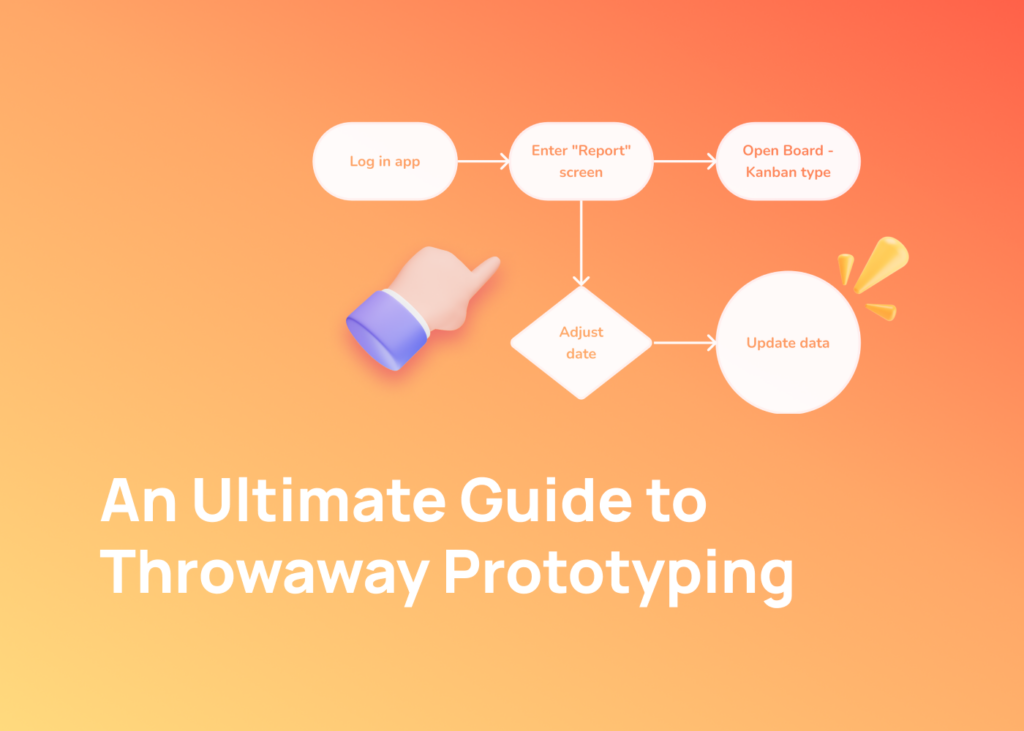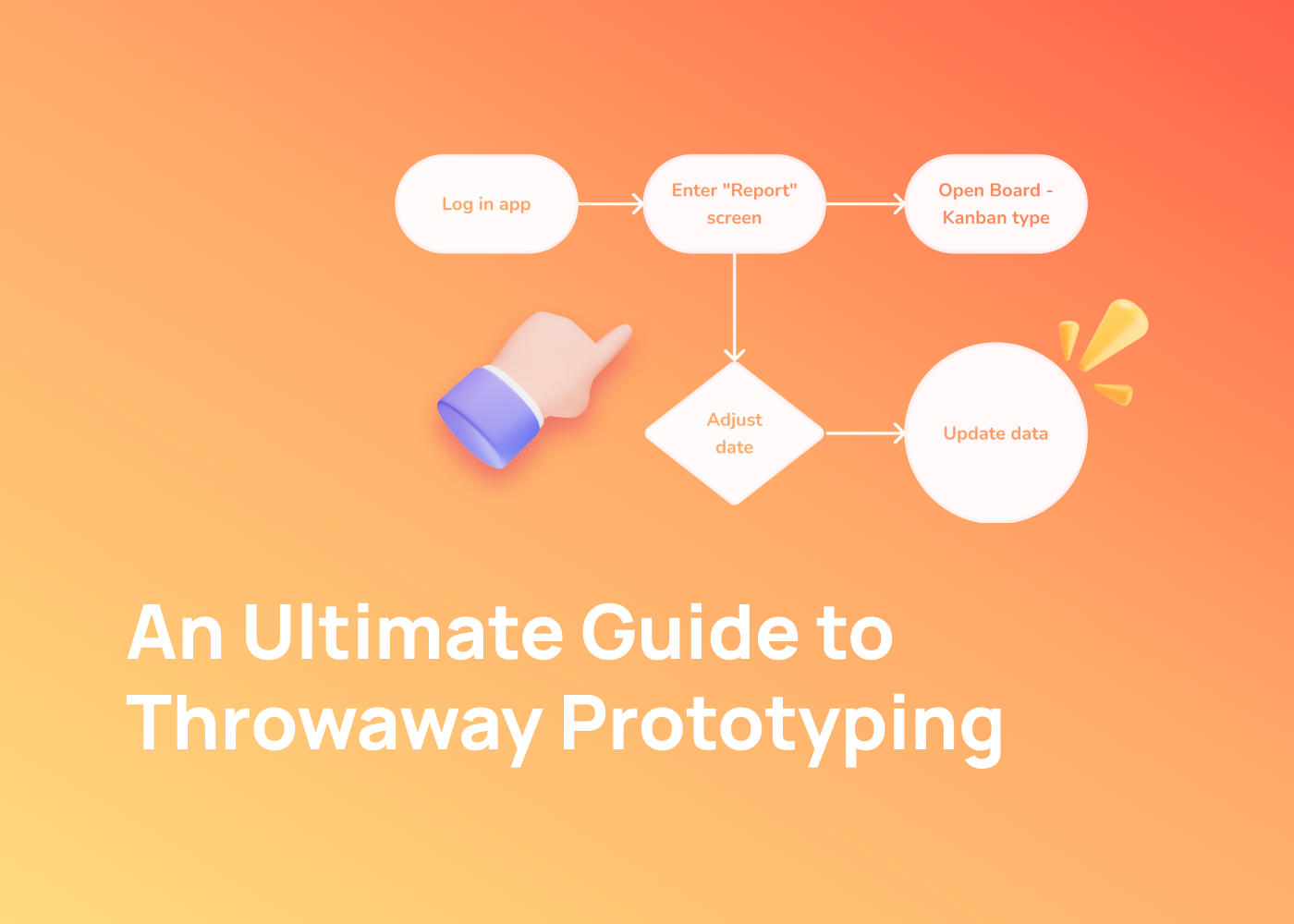Designing a digital product can be complex and challenging in today’s fast-paced digital world. We’ve all been there: hours spent testing, retesting, and adjusting features before a product sees the light of day. In this process, prototyping is a game-changing approach redefining how we think about design and development.
Several prototyping models are available: throwaway, evolutionary, extreme, and incremental prototyping. Each of them serves different purposes. These models help designers and developers visualize their ideas and test their functionality before the product is fully developed. Among these models, throwaway prototyping, also known as rapid or close-ended prototyping, is one of the most popular and widely used.

Throwaway prototyping is a method that involves creating a scaled-down version of the product, which is then tested and discarded or ‘thrown away.’ This model is beneficial when the development team needs clarification about the product’s details, such as its functionality or user interface.
At its core, prototyping is about trial and error. It’s the art of creating versions of your digital product to see what works best. Yet, it often comes with a cost in terms of time and resources. This is where the brilliance of throwaway prototyping shines. Instead of being tethered to the first solution or design that comes along, this method encourages exploration and experimentation. In other words, it’s about making the most of your efforts and ensuring you find the best solutions, not just the first ones.
In this ultimate guide, we’ll dive deep into the world of throwaway prototyping. We’ve got you covered from its fundamental principles to practical tools and techniques.
What is throwaway prototyping?
Throwaway prototyping, also known as rapid or close-ended prototyping, refers to creating a model that is eventually discarded rather than becoming part of the final delivered product.
This method is used in the development process. It involves creating a simple model, or a throwaway prototype, of a product. This model is used to test and validate the design and features of the product.
The key idea behind this method is to create a working model quickly. This is also known as rapid prototyping. The model is then used to identify any issues or improvements needed.
Once the testing is done, the prototype is discarded or ‘thrown away.’ Hence, the name ‘throwaway prototyping.’ The insights gained from this process are then used to create a new and improved prototype.
This cycle of creating, testing, and discarding continues throughout development. This is until the final product meets the desired standards. Throwaway prototyping is a crucial part of the development cycle. It helps to save time, and resources and ensures a quality product.
How to Execute Throwaway Prototyping Model
Let’s look at how to use the throwaway prototyping model.
Step 1: Understand the Requirements
First, you need to understand the goals. Talk to the client or the team. Get a clear idea about what the product should do.
Step 2: Create a Basic Design
Next, make a simple design. It should show the main features.
Step 3: Build the Prototype
Now, create a basic model. This is the throwaway prototype. It should be easy to make. It should also show the main features.
Step 4: Review and Test
Next, check the prototype. Test it to see if it works well. Look for any issues to improve.
Step 5: Get Feedback
Then, show the prototype to the client or team. Get their thoughts. They might have ideas to make it better.
Step 6: Discard the Prototype
After that, stop using the prototype. This is why it’s called ‘throwaway’ prototyping.
Step 7: Use the Insights
Finally, use what you learned. Make a new and better prototype. Repeat the steps until the final product is perfect.
Remember, the goal of throwaway prototyping is to save time and make a good product.
When to Use Throwaway Prototyping
Throwaway prototyping is a powerful tool. But it’s not always the best choice. Let’s look at when to use it.
Unclear or Evolving Requirements
When the needs are not clear, use this method. It helps to understand the needs better. You can make changes easily.
High Stakeholder Involvement
If there are many people involved, this method is ideal. It allows everyone to give input. This leads to a better product.
Complex Systems
For complex systems, this method is useful. It helps to break down the complexity. You can focus on one part at a time.
Risk Mitigation
This method helps to reduce risks. By testing early, you can find issues. This prevents problems later on.
Innovative Ideas
For new ideas, this method is great. It allows you to test the idea quickly. You can see if it works or not.
Tight Timeframes
If you have limited time, use this method. This will accelerate product development because you can test and improve quickly.
User-Centric Design
For designs focused on the user, this method is ideal. It allows you to test the design with users. You can then improve based on their feedback.
Budget Constraints
If you have a tight budget, this method can help. It saves money by finding issues early. This prevents costly changes later on.
Training and Familiarization
This method is good for training. It helps people to learn about the product. They can use the prototype to understand it better.
Advantages of Throwaway Prototyping
The throwaway prototyping model brings several advantages to the table in software development. Here are some key benefits:
- Quick Feedback: The development team can get quick feedback on the prototype model with throwaway prototyping. This helps in making necessary improvements in the early stages.
- Saves Time: Creating multiple throwaway prototypes can save time. It allows developers to identify and fix issues before the entire system is built.
- Reduces Risk: The final system’s failure risk is reduced. This is because potential problems are identified and rectified during the prototyping phase.
- Enhances User Interface: Throwaway prototyping is a great way to enhance the user interface. It allows testing and refining the interface based on prototype user feedback.
- Validates Initial Requirements: It helps validate the software’s initial requirements. This allows the development team to make necessary changes before the final system is developed.
- Encourages Innovation: Throwaway prototyping encourages innovative solutions. Developers can explore different approaches to meet project requirements by creating and discarding prototypes.
- Improves Customer Satisfaction: The process allows for customer feedback at an early stage. This ensures that the final product aligns with customer expectations, increasing satisfaction.
- Cost-Effective: It’s a cost-effective approach to software prototyping. Identifying issues early on saves money that would otherwise be spent on fixing problems in the final product.
Disadvantages of Throwaway Prototyping
Despite the numerous benefits, throwaway prototyping also has its downsides. It’s essential for project managers and prototype developers to be aware of these potential pitfalls to ensure the project’s success.
- Misleading Results: A throwaway prototype model can sometimes give misleading results. The prototype is often built using a different programming language or technology than the finished system. Therefore, the prototype might not work in the actual product.
- Time-Consuming: While throwaway prototyping can save time in the long run, it can also be time-consuming. Creating different prototypes, testing them, and discarding them can take longer than expected, especially early in the development phase.
- Waste of Resources: Throwaway projects can lead to a waste of resources. This is because every discarded prototype represents time, effort, and materials not used in the final product.
- Miscommunication: This is because the prototype might only partially represent the final product, leading to misunderstandings about the project’s direction.
- Over-Reliance: There can be an over-reliance on the prototype. This is because the ease and speed of creating a throwaway prototype can lead to a lack of thorough planning and analysis.
- Lack of Documentation: Throwaway prototyping often needs proper documentation. This can make tracking changes and improvements made during the development phase difficult.
- False Sense of Progress: The rapid creation and discarding of prototypes can give a false sense of progress. Developers might feel they are making significant strides, while in reality, they need to move closer to a finished system.
Difference between evolutionary and throwaway prototyping
Evolutionary prototyping and throwaway prototyping are two different methods used in product development. Both have their unique characteristics and uses.
Evolutionary prototypes involve creating a basic version of the product. This version, known as an evolutionary prototype, is refined and improved over time. The goal is to evolve the product based on user feedback and testing. This method is useful when the final product is complex. It allows developers to tackle specific tasks one at a time. It also helps to gather feedback and make improvements throughout the developmental cycles.
On the other hand, throwaway prototyping involves creating a model that is discarded after use. The purpose of this method is to test ideas and find better solutions. It is useful when the requirements could be clearer early in the development process. The throwaway prototype is used to clarify requirements and design decisions.
Throwaway and evolutionary prototyping both have their places in product development. The choice between the two often depends on the project’s needs and available resources. While evolutionary prototyping is iterative and focuses on constant refinement, throwaway prototyping is about quick testing and learning. It’s about discarding what doesn’t work to make room for what does. Both methods aim to create a better final product.
Final Thought
Throwaway prototyping is a key component in digital product development. It provides a quick testing and learning platform, even with limited resources. It allows you to create an actual prototype, test it, and discard it, saving time and resources. Despite some challenges, like dealing with complex languages, it helps clarify requirements early in development. This method can greatly enhance user experience and foster innovation. However, choosing a prototyping method that fits your project’s needs is crucial.
If you’re ready to embrace rapid testing and learning, Visily can help you start with throwaway prototyping today. Explore and experiment with Visily to discover the potential improvements it can bring to your product.




